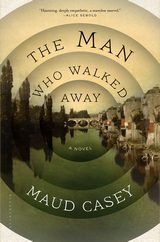 In her new novel, The Man Who Walked Away, Maud Casey examines the history of psychology: both its inception and the powerful draw for doctors trying to uncover the causes of man’s mental illness during the early days of the field. Inspired by the real story of a late 19th Century man, Albert Dadas, afflicted by “traveling fuge,” or dromomania, The Man Who Walked Away imagines Albert’s treatment and relationship with his doctor.
In her new novel, The Man Who Walked Away, Maud Casey examines the history of psychology: both its inception and the powerful draw for doctors trying to uncover the causes of man’s mental illness during the early days of the field. Inspired by the real story of a late 19th Century man, Albert Dadas, afflicted by “traveling fuge,” or dromomania, The Man Who Walked Away imagines Albert’s treatment and relationship with his doctor.
Albert walks and walks until he falls over from exhaustion, traveling always in a fog. He wakes in unfamiliar cities and finds himself thrown in jail. He walks so much that he forgets his home and his past, losing more and more of himself with every step. Movement is a compulsion, and causes Albert to forfeit human connection and defy any attempts to keep him restrained. The Man Who Walked Away traces his journey, but is most compelling in the description of his encounters with the doctor who tries to unlock the secrets in his past. Their symbiotic relationship is the heart of this elegant, thoughtful novel.
Casey describes Albert’s walking impulse as a powerful force. Yet the heartbreak of his affliction is that he is unaware of both the impulse’s origin and how to explain it to others.
“How was he to explain there was a moment while he was walking, silky as mist, when he forgot his father altogether? A moment when he was and was and he was only here. How could he possibly describe the secret silky song of his body? He could not. He could not. He cannot.
What does it feel like to walk, Albert?
He could not describe it then. He cannot describe it now.”
Albert’s memories come back to him (and are thus revealed to the reader) in unclear flashes: bits of story or conversations between himself and his father from before he started to walk. He largely remains a mystery to himself, which makes him even more enticing to the doctor. Through their conversations and hypnotic sessions, Casey also explores concepts of memory and language.
For each of the patients in the story, Albert included, there is a need to be grounded or recognized. Albert first grounds himself by looking at his feet. “They are a reminder: You are here, you are here.” Later, it is the doctor who uses touch and empathy to show his patients recognition. Even as he seeks answers within the fog in Albert’s mind (“The man’s mind is a dark street and the Doctor will light the lamps, one by one.”), he reminds Albert he will not let him leave. This presents an interesting thread–the idea of validation. Casey’s book suggests that above all else, patients want to know that they are seen. Valued. Believed. Mentions of hysteria and the medical community’s search to uncover the invisible causes of female madness remind us that psychology in this era was still in its infancy. The fact that Albert’s doctor realizes the importance of simple recognition differentiates him from others in the field at the time.
The idea of language and memory permeates Casey’s book, and at times she shows us not just the origins of psychological conditions, but the language to describe them as well.
“’Why do you cry?’ the Doctor asks, gently coaxing [Albert] to lie down again. ‘We have only just started.’ He hopes to speak to the man a little longer. It is true what Nurse Anne said. He does not appear to be a vagrant, but he doesn’t appear to be a tourist, either. He is not, for example, the man the Doctor met on the train for whom travel is a souvenir, a lovely vase to be lifted from the mantelpiece and admired and then returned. Maybe he would go; maybe he wouldn’t. For [Albert] it appears that travel is a broken shard that has lodged inside of him, causing him not to be so much consumed by an obsession to pursue travel as consumed by travel itself. Travel from travail, bodily or mental labor or toil of a painful, oppressive nature. From the Old French, travail, suffering or trouble. In German, ‘tearing free.’ Travel, from the Latin word for a three-pronged stake.”
The doctor’s desire to apply whatever academic knowledge he has to Albert’s disease surfaces multiple times in the story. But there is also the idea that what plagues Albert is too great to be fully understood. Too mysterious. And though the doctor may touch the edges of it, he will never see a clear picture.
Albert and the doctor change each other. Their meeting and subsequent relationship is as important for doctor as patient.
“…[T]he before is fading. A small corner of the Doctor’s mind remains tethered to his daily life before, but here in the after, the rest has been given over to the question of our traveler, his traveler. Someone comes. And you are changed.”
Throughout all of this is a sense that not only does this case change the doctor, but it changes–in some small way–the burgeoning field of psychology, too. We can’t accept this fictionalized account as hard-and-fast-truth, but we must assume that it is reflective of cases that were being examined in the late 19th century as the field of psychology struggled to define itself and justify its value. Casey does a nice job of creating a case that feels emblematic.
The doctor in The Man Who Walked Away is trying to solve an unsolvable mystery. Over the course of the novel he and the reader are able to gain a sense of Albert’s past through the collage of images Casey creates, but the fragmented nature of the story–intentionally, one would think–means we are never privy to a cause and effect relationship. This is not criticism. In fact, Casey writes Albert’s story in a form that feels true to its content. He is a mystery, even to himself. He is walking, unseeing, and he doesn’t so much obfuscate interpretation as suffer from a general lack of self-awareness. What becomes of Albert, eventually? There’s a spoiler in the title.




